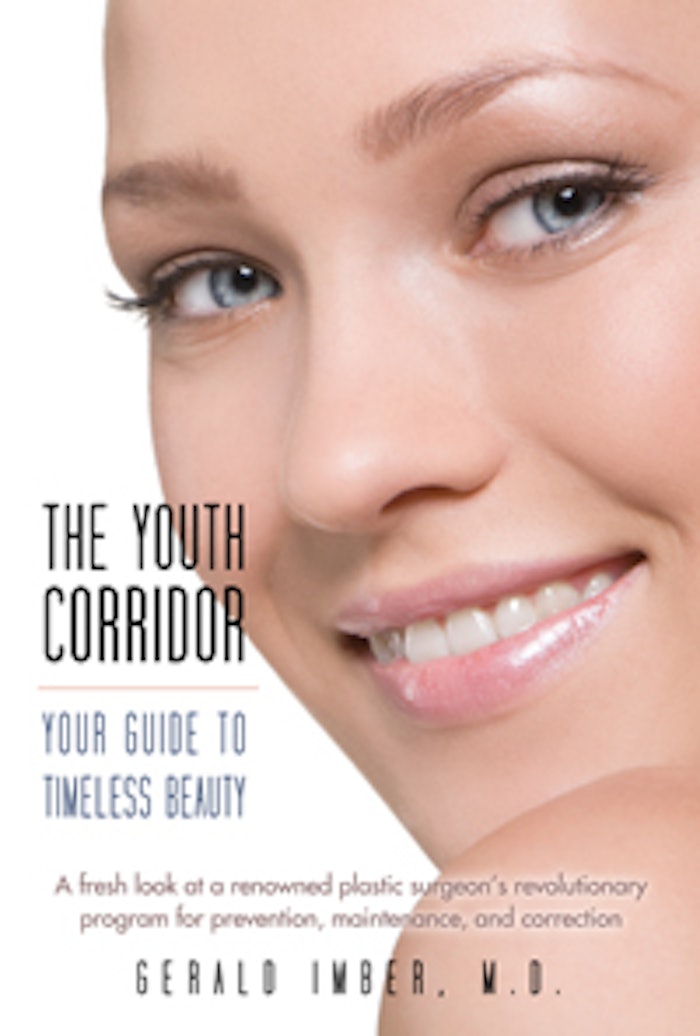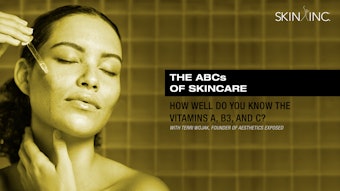
By Gerald Imber, MD, the author of The Youth Corridor: Your Guide to Timeless Beauty (KCM Publishing, 2013).
Two scientific terms that have become unavoidable are free radicals and antioxidants. These are now understood to be crucial issues in the health and beauty of one's skin, so pay attention. Free radicals are charged chemical particles of oxygen that enter into destructive chemical bonds with organic substances such as proteins. The result is an oxidation, or chemical burning, of the substance, which destroys it. Protein is denatured, genes may be broken and dangerous residual substances may result from the chemical changes. Examples of oxidation in nonscientific daily life include the rusting of an iron grill left in the atmosphere, the quick browning of cut potatoes, peaches or avocados left in the open air. It is interesting to consider that when a sliced avocado or peach is treated with lemon juice (a source of the antioxidant vitamin C), it does not brown. But before we jump to the conclusion we wish to see, immersing them in water inhibits the oxidation as well. Knowledge of all this has been around for a long time, though only recently has the process become a consuming interest of researchers and health faddists alike. At the same time that the destructive capabilities of free radicals were becoming known, many compounds that combat this destructive oxidation were identified. They are known as antioxidants, and include among their number many vitamins that were felt to be healthful even before the reasons were clarified.
Various activities of daily life have been shown to increase the presence of oxygen free radicals associated with destructive oxidation. Exposure to sunlight is known to lead to oxidative destruction of the skin, including increased incidence of skin cancer and the collagen-destroying processes causing wrinkling. Strenuous aerobic activity has been associated with increased free radical formation. But while athletes produce more free radicals, they may have also developed a more effective method of combating the damage with natural antioxidants. The evidence of free radical production leading to oxidation and tissue damage is real; some of the findings are confusing, and we are only just scratching the surface of understanding a very important mechanism.
Vitamin C
Vitamin C has been given credit for all sorts of miracles, proven and unproven. It is a potent antioxidant and a necessary component of tissue collagen production. Again, we are advised that normal diets, including citrus fruit, provide adequate vitamin C. Over the years scientists and clinicians have waffled over claims for the ability of vitamin C to prevent colds and lessen the length of time that symptoms persist. It is generally believed that these qualities are overstated or wrong. One study did show vitamin C to be effective in preventing cold symptoms in 50% of marathon runners tested but only a tiny percentage of the general population. Since I'm so set against subjecting one's body to marathon running, I nearly opted to leave that bit of information out. The significance of all this is confusing.
Antioxidants such as vitamin C are key players in the prevention of cholesterol plaques forming in the arteries and are generally necessary for sustained good health. The importance of vitamin C is well-known for its role in the healing of wounds and maintenance of the integrity of tissues. It is important in collagen synthesis, and its absence causes the disease scurvy, which results in tissue breakdown and open wounds. This was in the past a common condition suffered by sailors during long sea voyages. The association of citrus fruit with prevention of the disease led to British ships carrying stores of limes for consumption on extended passages, hence earning British sailors the nickname "limey."
Excess vitamin C is quickly and harmlessly excreted in the urine. Most proponents believe that 1,000 milligrams per day is adequate for the desired antioxidant effect. A 2008 study quantified the ability of 1,000mg/day of vitamin C to clean up the free radical in muscle after exercise, but questions whether this is beneficial. I'm confused, and I'm sure you are too. Stay tuned—there is surely more to come.
Everything considered, I continue to recommend, and use, daily supplements of 1,000 milligrams of vitamin C.
Vitamin C has also been shown to be a powerful antioxidant when applied to the skin. This is where real progress is being made. Free radicals derived from metabolic processes interfere with the production and maintenance of collagen in the skin. When collagen fibers are inadequate in number or misaligned, the skin structure breaks down and loss of elasticity and wrinkling result. Vitamin C protects the collagen in the skin and is necessary for new collagen production and wound healing. Free radicals from the environment have also been said to enter the skin and cause tissue damage, though how this happens is a mystery to me. The function of the skin is to keep the outside environment outside. That's how it works. And the difficulty in getting topical vitamin C into the skin illustrates that fact. But mechanisms aside, vitamin C applied to the skin can work if it can get into the skin in sufficient quantities. We will deal with this issue in depth a bit later in the text.
Vitamin E
Along with the knowledge of the destructive capability of free radicals is the knowledge that they are products of normal metabolism and are neutralized by antioxidants. These antioxidants are either enzymes within the body systems or antioxidants derived from the diet. The diet-derived group includes vitamin E (tocopherol), vitamin C (ascorbic acid), carotenes (vitamin A), and many others. Vitamins C and E are among the major nonenzymatic antioxidants that protect skin from the adverse effects of aging and sun damage, and for this purpose, topical application seems far more effective than oral supplements. We don't yet know how much is optimal for this function, but we are discovering how to most effectively deliver it to the skin. The fat-soluble vitamin E molecule is too large to penetrate the skin and significantly raise circulating levels, but application of vitamin E to the skin has consistently shown the ability to retard the inflammation from sun exposure and UVB damage and, in fact, reverse the sun damage. There is also a great deal of evidence that vitamins C and E are enhanced in their antioxidant function when applied together. Current conservative advice is that a diet rich in fruit and vegetables should be adequate for normal healthy adults. Daily oral supplements of vitamin E have long been recommended but have fallen into scientific disfavor due to conflicting reports. Some studies claim it promotes cardiac health; others contradict the findings. A 2009 study indicated that most basic studies were universally flawed and suggested that larger (and perhaps larger than tolerated) doses might be necessary to be effective. I no longer encourage taking vitamin E supplements until more information is available. The effect of vitamin E on the skin is another matter. All evidence indicates that it is an important element for maintaining youthful, healthy skin and preventing and reversing sun damage.
Topical antioxidants like vitamins C and E are potent tools for reversing sun damage to the skin. No one doubts their value; the issue is getting the large molecules through the skin, and a great deal of progress has been made on this front. Effective vitamin C serums are available, and they work. But delivering enough of the antioxidant remains a problem; measuring its effectiveness objectively is another. A relatively unexploited but easily documented property of topical antioxidants is their ability to prevent redness from sun exposure. Both vitamins C and E reduce the red inflammatory reaction from the sun when applied half an hour before exposure. This can be documented and crudely quantified, so we have a way of measuring results and comparing them. When C and E are applied together the effect is cumulative, in other words, more effective than either alone. When another antioxidant, melatonin, is added to C and E, the protective effect is many times greater than using C or E alone, or C and E in combination. Apparently, the addition of melatonin eases the entry of the antioxidants into the skin. This breakthrough has made the topical delivery of antioxidants into the skin a more effective reality. The unique quality of the combined antioxidants has been known for a number of years. Whether the reduced inflammatory response translates to fewer skin cancers is not yet clear. What is known is that vitamins C and E, combined with melatonin, drive antioxidants into the skin, and these same antioxidants have been shown to protect the skin from the inflammatory response to the sun and help reverse previous sun damage to the skin.
I think this represents great progress, and a serum containing potent levels of vitamins C and E and melatonin is now an important component of the Youth Corridor program.
Melatonin
Melatonin is produced by the pineal gland in the brain and is known to influence the circadian rhythms of the body: sleeping at night, being awake during the day. It has also been recognized as among the most powerful of antioxidants. The ability of melatonin to eliminate free-radical contamination in cellular function has been repeatedly demonstrated. And as noted above, it is very effective as a topical antioxidant in its synergetic action with vitamins C and E. The ability of melatonin to help drive vitamin C into the skin and its anti-inflammatory action have made it a very important ingredient in skin-care products. I believe the combination of vitamin C, vitamin E and melatonin represents the most truly effective way to get enough of these antioxidants into the skin to impede collagen destruction, encourage collagen production, reduce facial wrinkles and undo sun damage.
Natural antioxidants and antioxidant supplements
There are many antioxidant supplements available. Most of these compounds have beneficial properties in their natural state, which should not be overlooked. But the question is whether antioxidant supplements actually provide the help they promise. Systemic antioxidants are necessary to prevent the oxidation of LDL (bad) cholesterol, which then becomes layered into artery walls as life-threatening plaque. As recently as June 2009, the American Heart Association declined to underwrite the use of antioxidant supplements for this purpose. It concluded there is not enough evidence that vitamins C or E or beta-carotene supplements are of any benefit, though it encouraged the dietary intake of foods high in antioxidants in the natural state. Foods such as citrus fruits, carrots and pomegranates are high on the long list of healthy sources. Green tea is a great source of the powerful antioxidant group called catechins. Catechins have been credited with improving cardiac health, among other benefits, and many experts encourage consuming multiple cups of green tea daily. Numerous studies show the benefit of these catechins in boosting immune response and protecting against cancer. Green tea extract applied to the skin is active in protecting against skin cancers caused by UVB rays, the most dangerous wavelength in sunlight. There appears to be enormous value in consumption of green tea and its use in skin care preparations.
Decaffeinated tea retains its antioxidant value as well, so you can drink your antioxidant all day, buzz-free. Apparently, green tea is not baked in the production process and maintains more of its active catechins than other types of teas. Green tea has no calories, and though it is admittedly an acquired taste, once you get into it, it tastes great. Over the long haul, it may stain teeth slightly, as does coffee; but the simple expedient of brushing a few times daily seems to neutralize the problem.
Lycopene is perhaps the most potent dietary antioxidant. It is found in abundant supply in tomatoes, carrots and other yellow, red and orange fruits and vegetables. Its importance in cardiovascular health has been established, and one can infer that if it gets into the arteries it will also reach the skin. Here's the good news about lycopene: It appears to be most effective in the cooked state in tomatoes, and is most readily digested and absorbed in combination with fats such as olive oil and cheese. Which makes an excellent case for pizza.
Coldwater fish supply abundant amounts of healthy omega-3 fatty acids, while supplements may not. This does not mean that supplements do not help, simply that there is no evidence of that help. That is not the same thing. In the case of beta-carotene supplements, there is evidence of significant negative impact of high doses on the survival of some cancer patients.
The point of all this is, don't let any food faddist, vitamin salesman or profiteer fool you. There is no clear, scientific evidence that supplements can do the same job as healthy eating. So, why do I continue to use and suggest vitamin C supplements? The evidence of its effectiveness comes and goes in waves. There is nothing to indicate vitamin C is harmful, and reputable scientific investigators have taken both sides of the question over the years. But one would not be wrong in abandoning vitamin C supplements as well.
For more information please visit www.youthcorridor.com and follow him on Facebook and Twitter.










